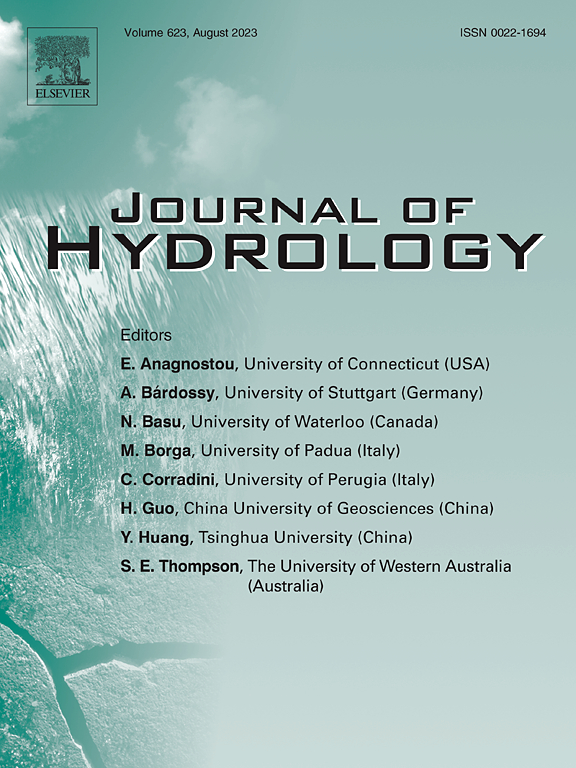Suspension dynamics of sand-silt mixtures: experimental insights and modelling implications
IF 5.9
1区 地球科学
Q1 ENGINEERING, CIVIL
引用次数: 0
Abstract
Tidal flats are typically rich in fine-grained sediments, with tidal currents serving as the dominant hydrodynamic force. Sediment transport, mainly in the form of suspended load, is especially active in the mid- to low-tidal zones, where silt-rich sediments prevail. In these zones, variations in silt content significantly influence sediment suspension dynamics. To investigate the effect of silt content on the suspension behaviours of sand-silt mixtures under unidirectional flow, a series of experiments has been conducted in an annular flume. Sediment samples collected from silt-enriched tidal flats were remixed into seven types of sediment beds with the silt content ranging from 19 % to 79 %. Results indicate that under steady current conditions, the suspended sediment concentration (SSC) in sand-silt mixtures increased toward equilibrium. Sediment beds with 36 %–60 % silt content exhibited two-stage erosion behaviour, each marked by distinct characteristics. At low to moderate shear stress (0.18–0.74 Pa), smoother bed surfaces and hiding-exposure effects led to higher near-bed velocities and lower equilibrium SSCs. At higher shear stress levels (1.00–1.23 Pa), this behaviour shifted, with prolonged suspension development becoming the key feature. Based on the experimental findings, we further re-calibrated the equations predicting equilibrium SSC, which can be well described by a modified excess shear stress to the power of two. Subsequently, we investigated the boundary conditions that govern sediment suspension to model the observed suspension process. Building on the boundary condition prescribing a constant upward sediment flux, an asymptotic upward flux condition, which represents the delayed erosion response due to the resistance of silty bed structure, has been introduced and demonstrated as the most feasible. Furthermore, the development of SSC towards equilibrium was investigated. This process is well characterised by a time scale, which becomes notably larger for sediment beds with 36 %–60 % silt content at high velocity levels, reflecting their delayed response in suspension. These findings elucidate key mechanisms governing silt-dominated sediment erosion, enhancing predictive capabilities in modelling mixed sediment transport.
泥沙混合物的悬浮动力学:实验见解和模型含义
潮滩通常富含细粒沉积物,潮汐流是主要的水动力。泥沙输运在中低潮带尤其活跃,主要以悬移荷载的形式进行。在这些带中,泥沙含量的变化对泥沙悬浮动力学有显著影响。为了研究泥沙含量对单向流动条件下泥沙混合物悬浮特性的影响,在环形水槽中进行了一系列试验。从富粉潮滩采集的沉积物样品被重新混合成7种泥沙层,泥沙含量在19% ~ 79%之间。结果表明,在稳定水流条件下,泥沙混合物中悬浮泥沙浓度逐渐趋于平衡。含粉量为36% ~ 60%的沉积层表现为两阶段侵蚀行为,各阶段侵蚀特征明显。在低至中等剪切应力(0.18-0.74 Pa)下,光滑的床面和隐藏暴露效应导致近床层速度增大,平衡SSCs降低。在较高的剪切应力水平(1.00-1.23 Pa)下,这种行为发生了变化,长时间的悬浮发展成为关键特征。根据实验结果,我们进一步重新校准了预测平衡SSC的方程,该方程可以用修正的过量剪切应力的2次方来很好地描述。随后,我们研究了控制泥沙悬浮的边界条件,以模拟观测到的悬浮过程。在规定恒定向上泥沙通量的边界条件的基础上,引入了代表粉质层结构阻力引起的延迟侵蚀响应的渐近向上通量条件,并证明了该条件是最可行的。此外,还研究了SSC向平衡态的发展。这一过程有一个很好的时间尺度特征,在高速水平下,泥沙含量为36% - 60%的沉积物层的时间尺度变得明显更大,反映了它们在悬浮中的延迟反应。这些发现阐明了控制粉砂质泥沙侵蚀的关键机制,增强了模拟混合泥沙输运的预测能力。
本文章由计算机程序翻译,如有差异,请以英文原文为准。
求助全文
约1分钟内获得全文
求助全文
来源期刊

Journal of Hydrology
地学-地球科学综合
CiteScore
11.00
自引率
12.50%
发文量
1309
审稿时长
7.5 months
期刊介绍:
The Journal of Hydrology publishes original research papers and comprehensive reviews in all the subfields of the hydrological sciences including water based management and policy issues that impact on economics and society. These comprise, but are not limited to the physical, chemical, biogeochemical, stochastic and systems aspects of surface and groundwater hydrology, hydrometeorology and hydrogeology. Relevant topics incorporating the insights and methodologies of disciplines such as climatology, water resource systems, hydraulics, agrohydrology, geomorphology, soil science, instrumentation and remote sensing, civil and environmental engineering are included. Social science perspectives on hydrological problems such as resource and ecological economics, environmental sociology, psychology and behavioural science, management and policy analysis are also invited. Multi-and interdisciplinary analyses of hydrological problems are within scope. The science published in the Journal of Hydrology is relevant to catchment scales rather than exclusively to a local scale or site.
 求助内容:
求助内容: 应助结果提醒方式:
应助结果提醒方式:


